The author, E Owen Clark, and the publisher/printer, Goddard, Walker and Brown Ltd London and Hull, have scant mentions on the internet; and none of those relate to design or artistic publications. Their wallpaper book is a fairly upscale production, so maybe they all missed their true calling. It took me a while to warm up to the scenes, but I'm definitely a convert: I really like these illustrations and the print quality is excellent.
The interior design, book-buying public of the 1910s were apparently expected to be well-versed in the esoteric language of wallpaper styles (according to the Foreword). For the modern ignoranti, a few definitions may help when reading the author's plate descriptions below (although, to be fair, all these terms are still in use today):
Anaglypta "refers to a range of paintable, textured wallcoverings made from paper or vinyl. It is produced on traditional paper and paste-the-wall substrates." [W].
Lignomur is a preparation of embossed wood fibre pasteboard.
Lincrusta is a deeply embossed, thick type of wallpaper made (in part) from linseed gel, which continues to dry and harden over many years. Think: Victorian buildings or, more recently, hotel foyers, bars and casinos etc.
Stile: "Frame and panel construction, also called rail and stile, is a woodworking technique often used in the making of doors, wainscoting, and other decorative features for cabinets, furniture, and homes." [W].
Frieze: a broad horizontal band of sculpted or painted decoration, near the ceiling.
Dado: "is the lower part of a wall, below the dado rail and above the skirting board." [W]
All but one of the book's illustrations are displayed below (I forgot to scan the other bathroom scene).
"The chromo paper on which these illustrations are printed is manufactured and coated at our Orchard Mills, Darwen." (Lancashire)
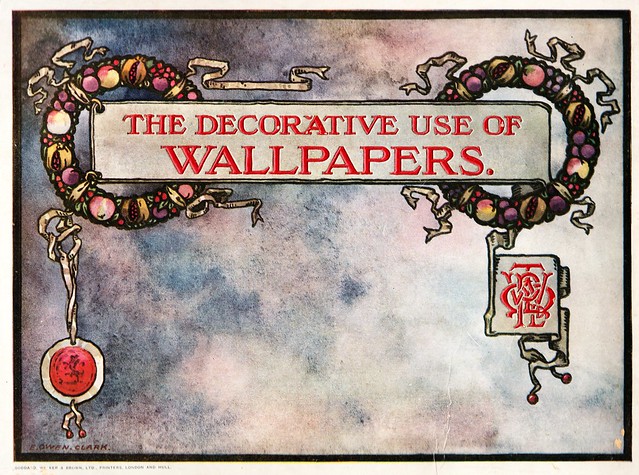
Foreword:
"The decorative schemes shewn here in the accompanying drawings have been produced with a view of demonstrating the possibilities of the artistic and intelligent use of wallpapers, rather than to advertise any particular pattern, and it is believed that they may be useful long after the actual designs shewn are obsolete.
It is common knowledge that to choose a pattern from a book, away from the room in which it is to be used, is often disappointing, nor, indeed, is it possible for the public to judge the effect of a pattern **in situ** at all from a a strip often less than 18 inches square. It has, therefore, been thought advisable to prepare the schemes here given, to show the general effect of the various types of wallpapers now in use.
Many of the plates are simply a happy combination of several papers. Thus - the Bathroom on page 19 is made up of a blue tile pattern varnished, with a stile of white crackle and a narrow border, an arrangement which can be carried out in a variety of ways with any suitable combination of papers, to fit any room which may have to be decorated. The Bedroom on page 19 is composed of a filling, with its 10.5 inch frieze used to form the walls into panels, and gives the impression of having been made to fit that particular room.
These instances could be multiplied, but, the drawings speak for themselves, and the compilers will feel that their work was worth doing, if, it induces the Decorator to make the best possible use of the means within his reach, and so add an increased beauty to his work, and give more pleasure to his customer than is possible by simply taking so many rolls of wallpaper and with them covering the walls.
Of the Relief Ceilings and Enrichments it seems unnecessary to speak, as the adaptability of Anaglypta, Lignomur, Lincrusta, and kindred productions, is well known wherever decoration is carried out, and patterns and devices can be had in such variety, that, it is possible to arrange them to fit any possible space which it may be necessary to enrich."
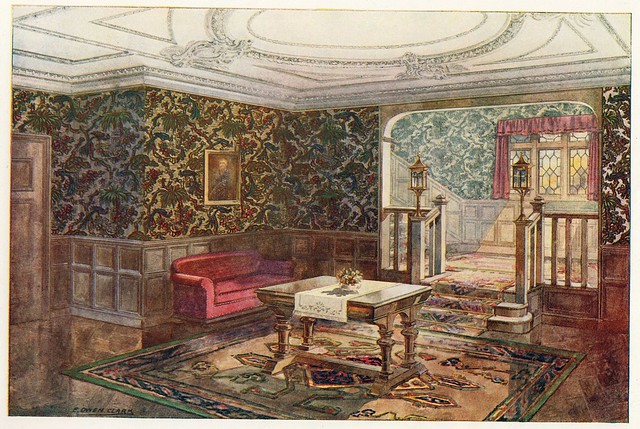
The filling is a Chinese Chippendale pattern on rich brown ingrain with high relief anaglypta to spaces of any shape. The dado is suitable for treatment either as wood or plaster.
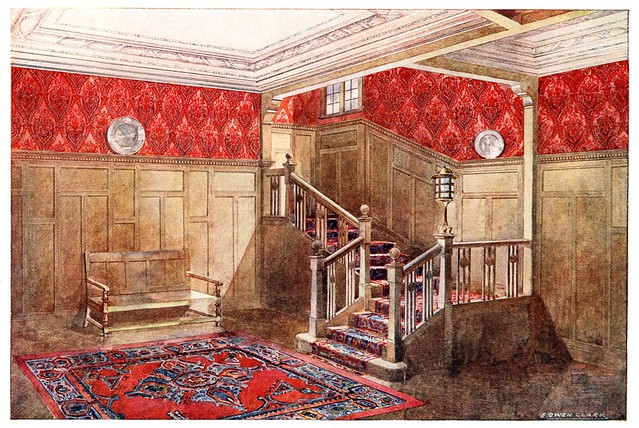
High wainscot dado of lincrusta, showing oak grain. The stiles are fixed separately, and can be arranged in any form of panelling. The ceiling border is of anaglypta in high relief, and can be panelled at will. The upper wall is covered with an engraved wallpaper.
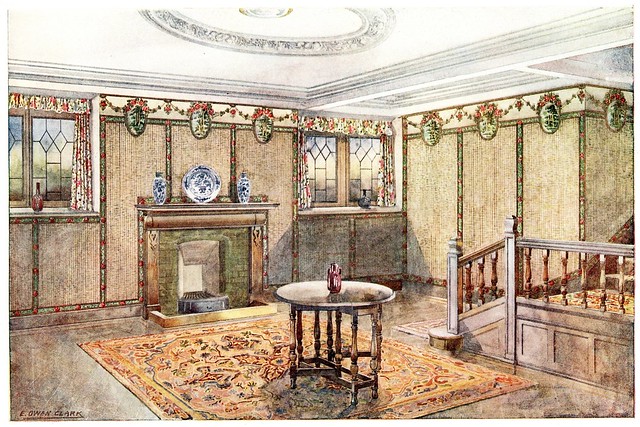
The walls are covered with an engraved textured wallpaper, with a cut-out frieze and border. The ceiling is of anaglypta.
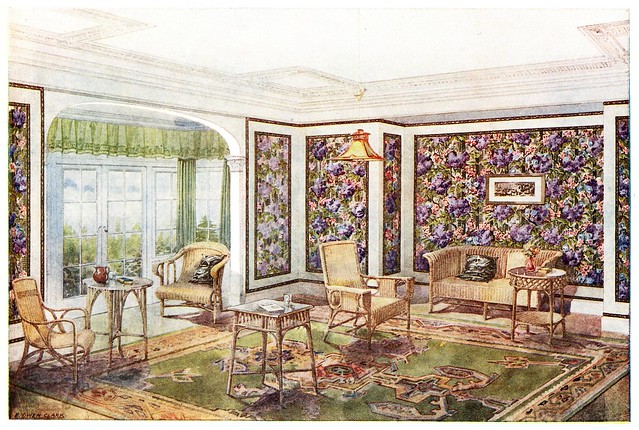
The walls are decorated with a filling shewing a rich modern treatment of the lilac - with combined stile and border 7 inches wide - and can be made up in panels of any size. The ceiling is formed of a high relief anaglypta border which can be arranged in many ways.
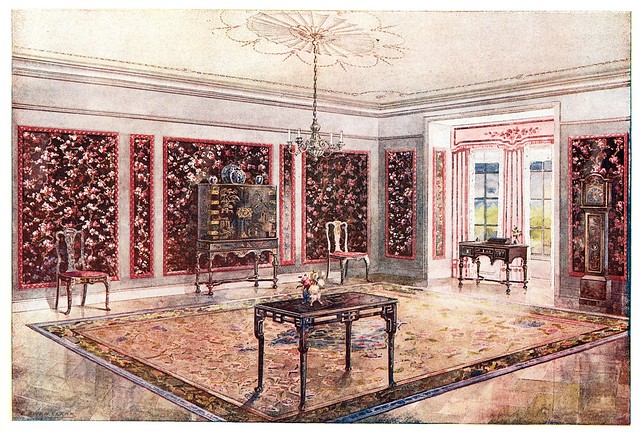
The walls are panelled with black satin paper covered with pink almond blossom and twisted ribbon border and plain grey stiles. The ceiling is of "Adam" design in anaglypta of high relief, which can be adjusted to fit a ceiling of any shape.
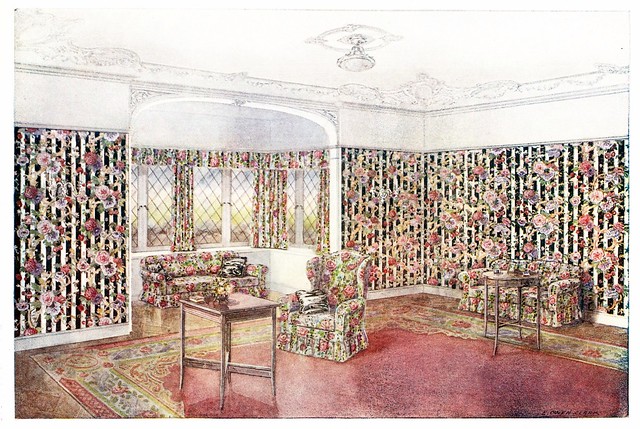
The walls are of rich flowered chintz paper with black stripes and plain frieze over. The ceiling is decorated with an adaptable high relief anaglypta of Louis XV design.

The walls are panelled with a satinette paper of soft grey and pink roses with border and frieze to match. The stiles are of moire satinette. This decoration can be arranged in panels of varying proportion to fit any give wall. The ceiling of "Adam" design, adaptable to any space, is in high relief anaglypta.
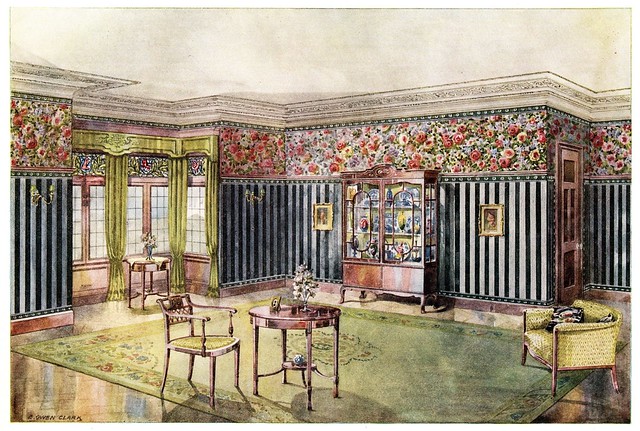
The upper wall is of richly flowered paper, which may be of any depth, with plain stripes underneath and finished with narrow borders. The ceiling border is of high-relief anaglypta.
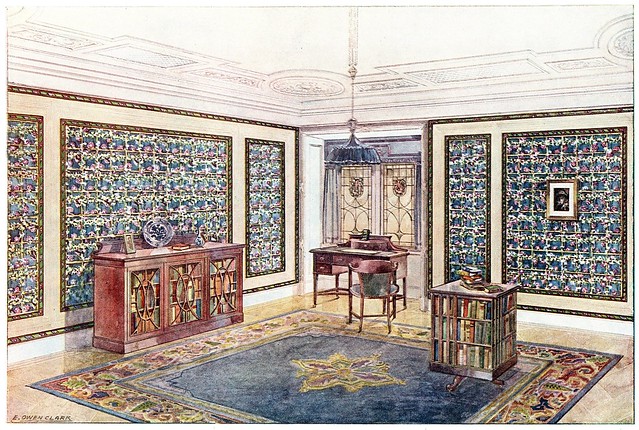
The walls are covered with a modern art trellis with flowers, and divided into panels by a combined stile and border 10.5 inches wide. The ceiling is of anaglypta in high relief. This
decoration is equally suitable for dining room or hall.
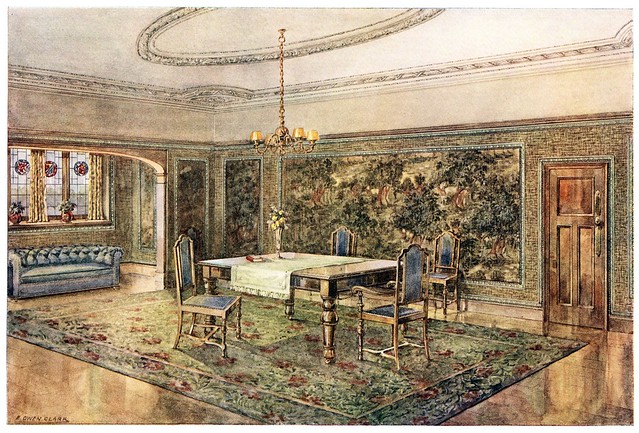
The walls are panelled with fine tapestry paper with borders and textured stiles, and plain frieze. The ceiling is of Georgian design in high relief anaglypta. This decoration is suitable for dining room or library.
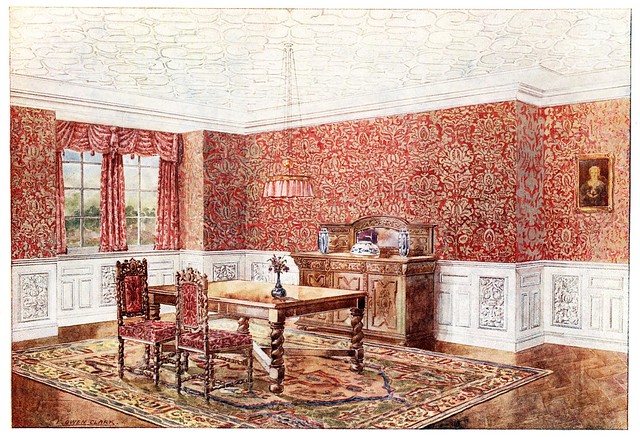
The upper walls are papered with a fine damask design, with dado and ceiling of high relief anaglypta. The dado is shown as plaster but might with equal fitness be treated as wood. The filling is equally suitable for hall or library.
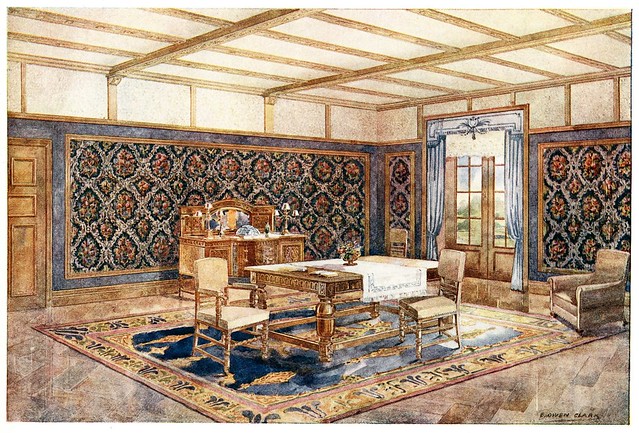
Panelled walls of fine tapestry, with stiles and lincrusta mouldings. The ceiling beams are decorated with anaglypta borders copied from old English carvings. The frieze and ceiling spaces are filled with rough cast design in lignomur.
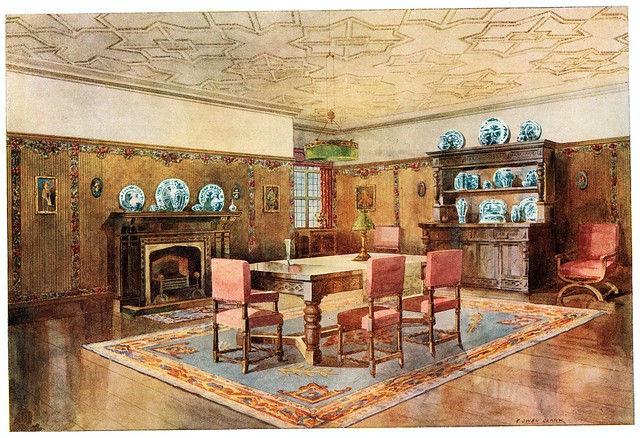
The walls are decorated with plain striped ingrain, panelled with cut-out borders, which can be arranged at will. The frieze is plain, and the ceiling of high relief anaglypta.
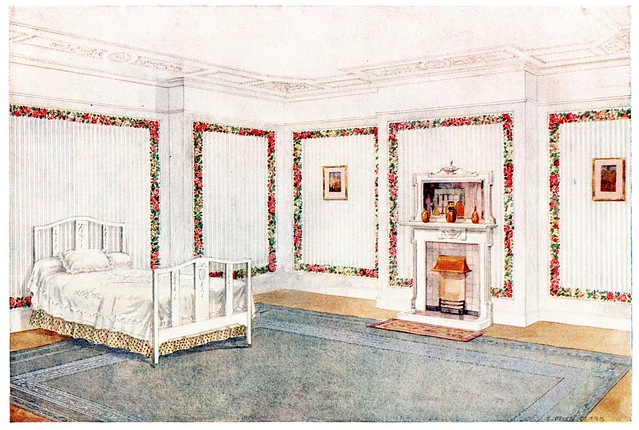
The walls of this bedroom are covered with a white satin striped paper, with rose border and moire satin stiles. The ceiling is of "Adam" design in anaglypta and is adjustable.
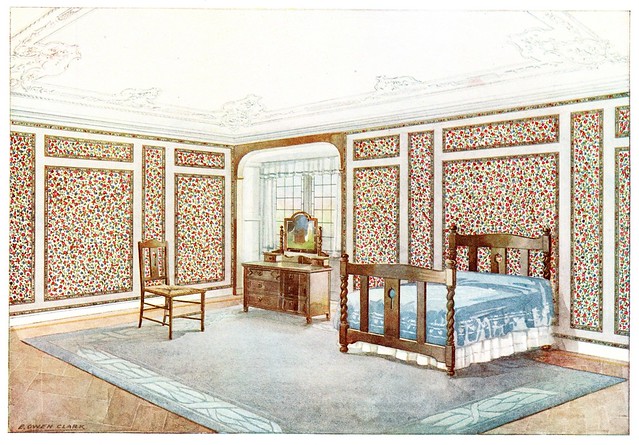
The panelled filling is all-over small flowers, with combined stile and border 7 inches wide. This scheme is capable of any adjustment in shape and size of the panels. The anaglypta ceiling is of high relief.

The walls are of soft grey with stripes of sweet peas, with cut-out frieze used as a crown to the filling and also in frieze space.
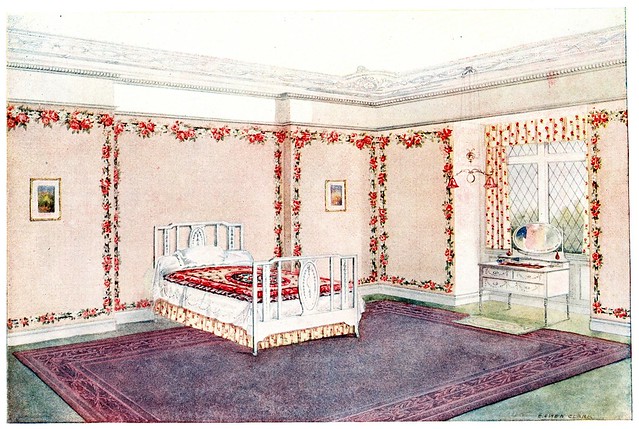
The walls are simple diaper in satinette, with cut-out frieze and border, and plain band over. The ceiling border is of high relief anaglypta.
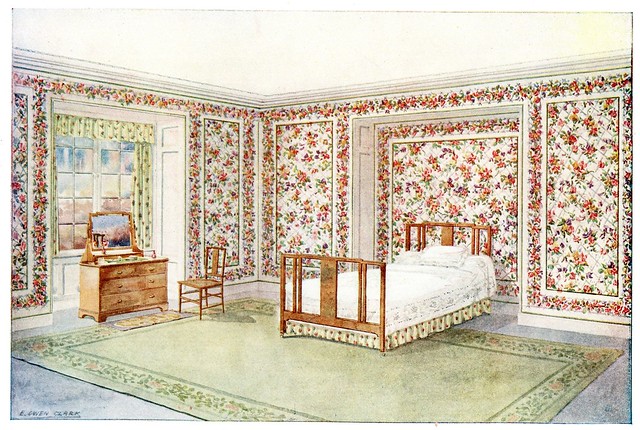
The filling is of sweet peas on trellis, divided into panels by a 10.5 inch border, and capable of adaption to any size wall.
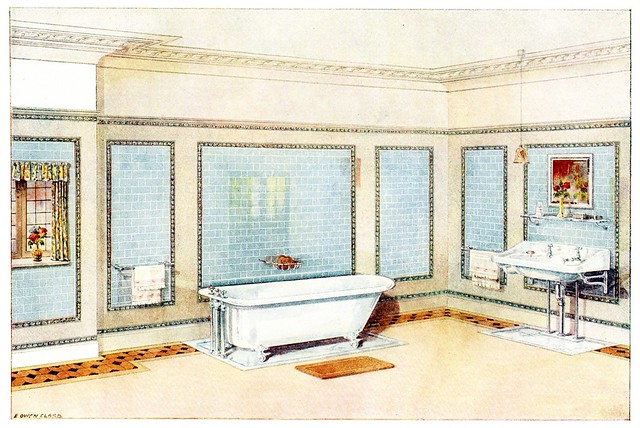
Panelled bathroom of plain blue varnished brick paper with stile of varnished crackle paper and narrow border. The ceiling has an anaglypta border.
- 'The Decorative Use of Wallpapers' (c. 1910 - according to the V&A) belongs to the collection of Colin R who kindly allowed me to scan the book.
- Thanks also to Gwyneth^ & Will C.
- This post first appeared on the BibliOdyssey website.
Thanks for scanning and sharing!
ReplyDeleteJust stumbled on your blog after a google search for 'falconry'. I am so excited to explore - Very exciting!
ReplyDeleteI'd so love wallpapers to make a comeback...
ReplyDelete